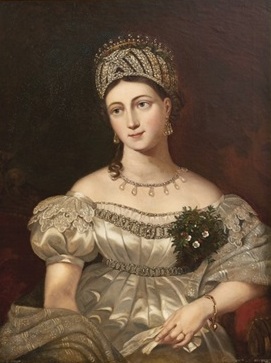by Susan Flantzer
© Unofficial Royalty 2015

Louise of Saxe-Gotha-Altenburg, Duchess of Saxe-Coburg-Saalfeld; Credit – Wikipedia
The mother of Prince Albert, Queen Victoria’s husband, Princess Louise of Saxe-Gotha-Altenburg (Luise Pauline Charlotte Friederike Auguste) was born on December 21, 1800, at Schloss Friedenstein in Gotha, Saxe-Gotha-Altenburg, now in Thuringia, Germany. Louise was the only child of Augustus, Duke of Saxe-Gotha-Altenburg and his first wife Louise Charlotte of Mecklenburg-Schwerin. Louise’s mother never recovered from childbirth and died eleven days later at the age of 21.
Louise’s father Augustus married again in 1802 to Princess Karoline Amalie of Hesse-Kassel. The marriage was childless, but Karoline Amalie was a devoted stepmother to Louise. Karoline Amalie and Augustus became estranged after a few years of marriage and Karoline Amalie withdrew from court life.
On December 20, 1816, the engagement of Louise and Ernst III, Duke of Saxe-Coburg-Saalfeld (later Ernst I, Duke of Saxe-Coburg and Gotha) was announced. The couple married on July 3, 1817, at Louise’s birthplace Schloss Friedenstein. The bride was 16 and the groom was 33. There is some indication that Louise had heard about Ernst’s womanizing before her marriage and his several illegitimate children, but she was optimistic about a happy life with him.
The couple had two sons:
- Ernst II, Duke of Saxe-Coburg-Gotha (1818 – 1893), married Princess Alexandrine of Baden, no children
- Prince Albert of Saxe-Coburg and Gotha (1819 – 1861), married Queen Victoria of the United Kingdom, had nine children

Albert (left) and Ernst (right) with their mother Louise; Credit – Wikipedia
Although the marriage was initially happy, the couple soon grew apart due to Ernst’s infidelities. In 1823, Louise had an affair with Gottfried von Bülow, the court chamberlain. The following year, she had an affair with Alexander von Hanstein, one of her husband’s equerries. At midnight on September 2, 1824, Louise was forced into exile and permanently cut off from her children. She was given a home in St. Wendel in the Principality of Lichtenberg, now in the German state of Saarland, which Ernst had received as a reward for his participation in the Napoleonic Wars. Louise suffered greatly due to her separation from her two sons. Images of her sons and visitation rights were denied to her. Ernst and Louise were divorced on March 31, 1826.
Louise’s lover, Freiherr (Baron) Alexander von Hanstein followed her to St. Wendel, and the couple planned to marry. In preparation for the marriage, Friedrich, Duke of Saxe-Altenburg created Alexander Graf (Count) von Pölzig and Beiersdorf on July 19, 1826. On October 18, 1826, Alexander and Louise were married in St. Wendel. They resided in the Schlösschen (Little Palace) there and spent some happy years, but the marriage was childless. Louise had a great interest in the social life of the Principality of Lichtenberg and was revered as its Landesmutter (mother of the country).

Bronze statue of Louise at the St. Wendel town hall; Photo Credit – Wikipedia
On February 16, 1831, Louise traveled with her husband to see doctors in Paris, France because of the deterioration of her health. Unfortunately, incurable cervical cancer was diagnosed. Louise died on August 30, 1831, in Paris at the age of 30. Louise’s embalmed body had been kept at the Schlösschen (Little Palace) in St. Wendel, but then, as a result of intrigues within the House of Saxe-Coburg, it somehow disappeared. First, the coffin found its way to a legal assistant’s house, and then in 1833 to the church in the village of Pfeffelbach in the Principality of Lichtenberg, where it lay in a simple crypt under the pulpit and was almost forgotten. On June 9, 1846, Louise’s coffin was taken to Coburg, where it stayed at the Church of St. Moritz, before being moved to the Ducal Mausoleum in Glockenberg Cemetery in 1860.
Louise’s widower Alexander remarried and had three children. In 1845, Alexander contacted his stepson Prince Albert, who in the meantime had married Queen Victoria, and Albert granted him a pension.

The Ducal Mausoleum in the Glockenberg Cemetery. photo: by Störfix – Selbst fotografiert, CC BY-SA 3.0, https://commons.wikimedia.org/w/index.php?curid=4010189
This article is the intellectual property of Unofficial Royalty and is NOT TO BE COPIED, EDITED, OR POSTED IN ANY FORM ON ANOTHER WEBSITE under any circumstances. It is permissible to use a link that directs to Unofficial Royalty.
